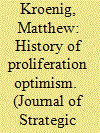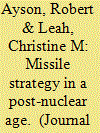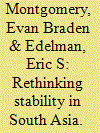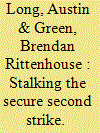|
|
|
Sort Order |
|
|
|
Items / Page
|
|
|
|
|
|
|
| Srl | Item |
| 1 |
ID:
137241


|
|
|
|
|
| Summary/Abstract |
Who did it? Attribution is fundamental. Human lives and the security of the state may depend on ascribing agency to an agent. In the context of computer network intrusions, attribution is commonly seen as one of the most intractable technical problems, as either solvable or not solvable, and as dependent mainly on the available forensic evidence. But is it? Is this a productive understanding of attribution? — This article argues that attribution is what states make of it. To show how, we introduce the Q Model: designed to explain, guide, and improve the making of attribution. Matching an offender to an offence is an exercise in minimising uncertainty on three levels: tactically, attribution is an art as well as a science; operationally, attribution is a nuanced process not a black-and-white problem; and strategically, attribution is a function of what is at stake politically. Successful attribution requires a range of skills on all levels, careful management, time, leadership, stress-testing, prudent communication, and recognising limitations and challenges.
|
|
|
|
|
|
|
|
|
|
|
|
|
|
|
|
| 2 |
ID:
137245


|
|
|
|
|
| Summary/Abstract |
This article questions the predominantly pessimistic assessments over the future of the Treaty on the Non-Proliferation of Nuclear Weapons (NPT). After analysing available evidence on states’ interests and interactions within the NPT’s framework, it argues that several negative expectations are unwarranted. Conversely, the article identifies three potentially threatening scenarios. Therefore, it scrutinizes the likely impact of reactive nuclear proliferation; analyses the probability of significant actors challenging the existent nuclear architecture; and explores whether the treaty’s enforcement might soon be diluted. The article concludes the NPT is unlikely to face fundamental threats in the foreseeable future.
|
|
|
|
|
|
|
|
|
|
|
|
|
|
|
|
| 3 |
ID:
137247


|
|
|
|
|
| Summary/Abstract |
This article analyses the impact of the Korean War on the Chinese People’s Liberation Army (PLA), particularly the period of positional warfare from 1951 to 1953. In the war of movement between October 1950 and June 1951, the PLA relied on its civil war era weapons and experience, including the doctrine of ‘battle of annihilation’. Operations in early 1951 suggested that the civil war legacies of the PLA no longer applied to the realities of combat in Korea. Based on both Soviet aid and domestic mobilisation, the PLA managed to build the material foundation for positional warfare and rapidly improved its logistics. Operationally, on the defensive, the PLA developed combined operations integrating infantry, artillery, and armoured forces. The PLA learned the lessons of the Korean War and strengthened its ties with the Soviet armed forces in order to modernise itself. The Korean War thus transformed the PLA from Civil War victor to Cold War guard.
|
|
|
|
|
|
|
|
|
|
|
|
|
|
|
|
| 4 |
ID:
137244


|
|
|
|
|
| Summary/Abstract |
Students of international politics known as ‘proliferation optimists’ argue that when it comes to the spread of nuclear weapons ‘more may be better’ because nuclear weapons deter great power war and produce greater levels of international stability. This essay provides a critique of proliferation optimism, challenging optimism’s conception of nuclear deterrence theory, its logical underpinnings, and its policy recommendations. It does this by conducting an intellectual history of proliferation optimism, identifying the core weaknesses of proliferation optimism as a theoretical framework, and articulating the myriad threats posed by nuclear proliferation.
|
|
|
|
|
|
|
|
|
|
|
|
|
|
|
|
| 5 |
ID:
137243


|
|
|
|
|
| Summary/Abstract |
While the arrival of nuclear weapons coincided roughly with the development of short, medium, intermediate, and eventually intercontinental missiles, the contribution of missile technology to the deterrence equation is often lost. If nuclear weapons were eliminated, even new generation missiles with conventional payloads could struggle to render effective deterrence. But some of the physical and psychological effects commonly ascribed to nuclear weapons could still be in play. And in a world without nuclear weapons, thinking about the use and control of force from the nuclear age would also deserve renewed attention.
|
|
|
|
|
|
|
|
|
|
|
|
|
|
|
|
| 6 |
ID:
137246


|
|
|
|
|
| Summary/Abstract |
India and Pakistan are currently engaged in a competition for escalation dominance. While New Delhi is preparing for a limited conventional campaign against Pakistan, Islamabad is pursuing limited nuclear options to deter India. Together, these trends could increase the likelihood of nuclear conflict. India, for example, might conclude that it can launch an invasion without provoking a nuclear reprisal, while Pakistan might believe that it can employ nuclear weapons without triggering a nuclear exchange. Even if war can be avoided, these trends could eventually compel India to develop its own limited nuclear options in an effort to enhance deterrence and gain coercive leverage over Pakistan.
|
|
|
|
|
|
|
|
|
|
|
|
|
|
|
|
| 7 |
ID:
137242


|
|
|
|
|
| Summary/Abstract |
Secure second strike nuclear forces are frequently held to be easy to procure. Analysts have long argued that targeting intelligence against relocatable targets like submarine launched and land mobile ballistic missiles is difficult to obtain. However, the scholarly consensus on intelligence for counterforce operations is seriously overdrawn. Both during and after the Cold War, the United States developed substantial intelligence capabilities to track and target submarines and mobile missiles. These efforts achieved important and under-appreciated success. Second strike forces have been far more vulnerable than most analysts are willing to credit.
|
|
|
|
|
|
|
|
|
|
|
|
|
|
|
|
| 8 |
ID:
138149


|
|
|
|
|
|
|
|